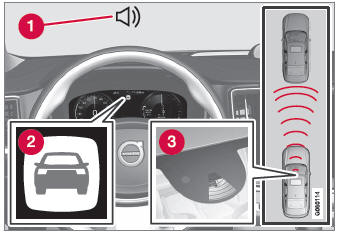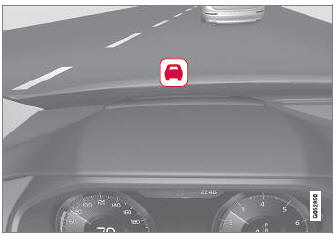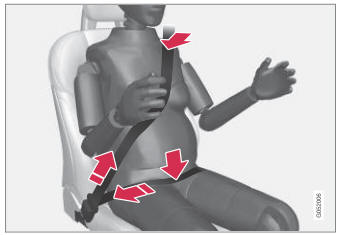Volvo XC90: Driver support / Collision risk warning from driver support
The driver support systems Adaptive Cruise Control* and Pilot Assist* can help alert the driver if the distance to the vehicle ahead suddenly decreases to an unsafe distance.

Collision warning audible signal and symbol
 Audible signal at risk of collision
Audible signal at risk of collision
 Collision warning symbol
Collision warning symbol
 Camera/radar sensor distance monitoring
Camera/radar sensor distance monitoring
Adaptive Cruise Control and Pilot Assist use approx. 40% of the braking capacity. If a situation requires more braking force than driver support can provide, and if the driver does not apply the brakes, a warning light and audible warning signal will be activated to alert the driver that immediate action is required.
WARNING
The driver support system only issues a warning for vehicles detected by its radar unit – thus, a warning may come after a delay or not at all. Never wait for a warning. Apply the brakes when necessary.

Collision warning symbol on the windshield
In vehicles equipped with a head-up display*, a flashing warning symbol will be displayed on the windshield.
NOTE
Visual warnings on the windshield may be difficult to notice in cases of strong sunlight, reflections, extreme light contrasts, or if the driver is wearing sunglasses or is not looking straight ahead.
* Option/accessory.
 Using passing assistance
Using passing assistance
Passing assistance can be used with Adaptive Cruise Control* or Pilot Assist*.
Several conditions must be met for passing assistance to be possible.
In order to activate passing assistance:
your vehicle must be following a vehicle ahead (target vehicle)
your vehicle's current speed must be at least 70 km/h (43 mph)
the set speed must be high enough to safely pass another vehicle...
 Switching target vehicles with driver support
Switching target vehicles with driver support
At certain speeds, vehicles with automatic transmissions and the driver support
functions Adaptive Cruise Control* and Pilot Assist* can switch target vehicles...
Other information:
Volvo XC90 2015-2025 Owners Manual: Activating auto climate control
If auto climate control is activated, several climate system functions are controlled automatically. Tap the symbol in the center of the climate bar to open Climate view in the center display. Tap or press and hold AUTO Climate/> Tap - air recirculation, air conditioning and air distribution are controlled automatically...
Volvo XC90 2015-2025 Owners Manual: Connected Safety limitations
Information on vehicles with activated hazard warning flashers or which have detected slippery road conditions is not always communicated between all vehicles in the affected area. This may be the case if: No or insufficient Internet connection. The maneuvers (steering wheel movements, acceleration or braking) made by the vehicles on slippery surfaces are too weak for friction between the t..

